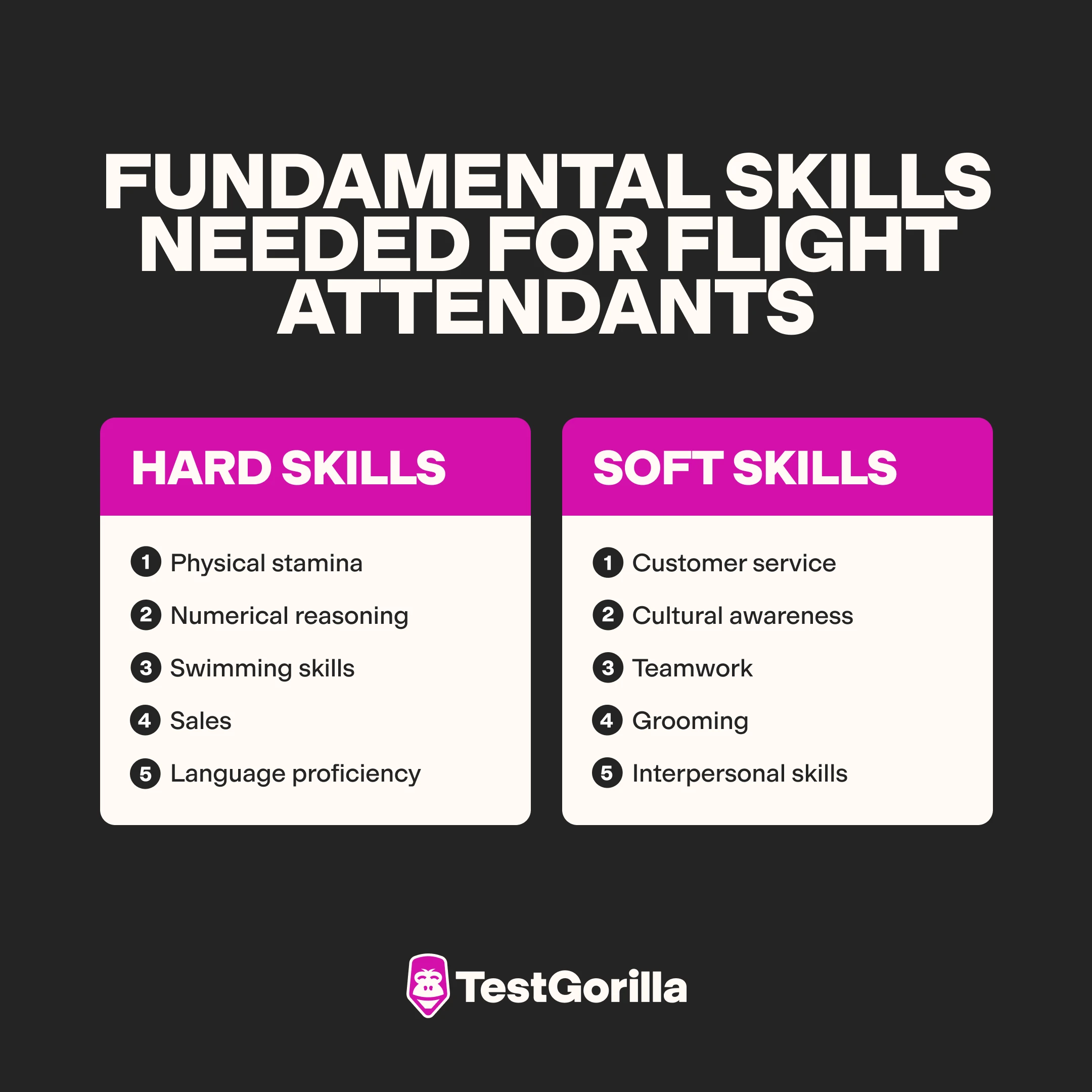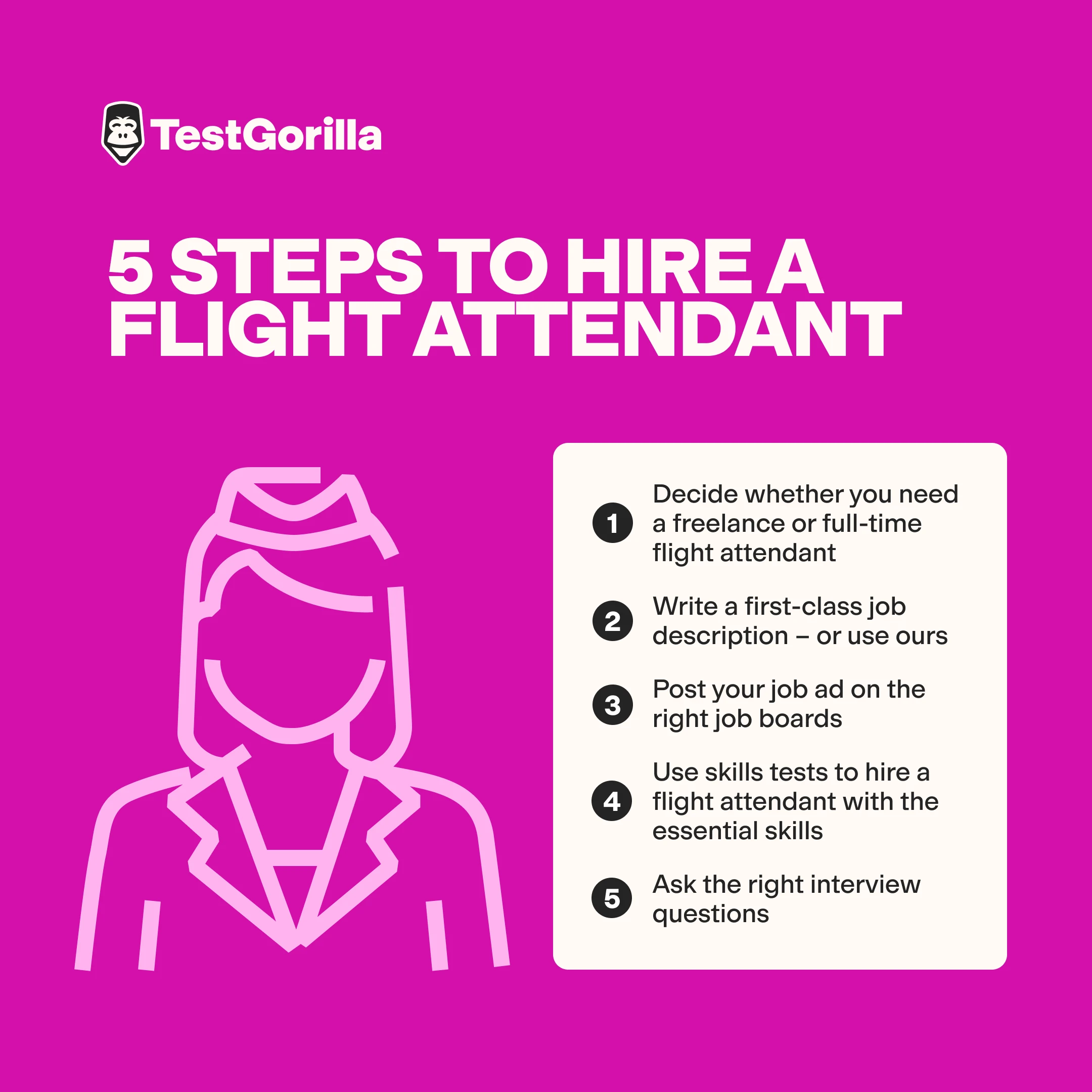Being a good flight attendant is about more than being able to put on a life vest and point to the exits.
The traits of a flight attendant should include the ability to communicate effectively and professionally with customers from across cultures, plus technical skills to manage the sales and safety tasks aboard an aircraft.
In this article, we discuss the skills you should look for when you hire a flight attendant and which flight attendant assessments to use.
Table of contents
What is a flight attendant?
A flight attendant is a person who looks after passengers in an airplane. They are responsible for passenger safety onboard the aircraft, briefing them on procedures and ensuring the flight deck is secure throughout the journey.
They are also responsible for serving passengers meals during flights and stocking the plane’s cabin with food and drinks.
A flight attendant must have a valid passport at all times, and many airlines also regulate their appearance, like asking them to cover all visible tattoos.
As flight attendants work with an airline, they receive promotions and move up a ranking system.
What are the ranks of a flight attendant?
The promotions progress along a system, with each rank having more expertise than the previous one. Here is the hierarchy of flight attendants:
Flight attendant. This starting point applies to every flight attendant. Before rising through the ranks, a flight attendant is responsible for basic things like monitoring passengers and stocking the cabin.
Purser. The role of a purser requires dedicated flight attendant training, which includes reviewing flight information and sharing important passenger information with the captain. They also attend to passengers who need special assistance and address misbehaving ones.
Chief purser. Chief pursers or in-flight managers report to the captain after the cabin is secure for takeoff and landing and give onboarding announcements. They require a minimum of 10 years of service in the airline and additional certifications.
Why should you hire a flight attendant?
If you run passenger flights, you are legally required to hire a flight attendant. The International Civil Aviation Organization requires that airline operators determine a minimum number of cabin crew for each aircraft type in its fleet, which the airline’s state must approve.
Every aircraft must have the staff required to carry out safety procedures for emergency situations.
For example, the Federal Aviation Administration in the United States mandates that a standard Boeing 737 with around 180 passengers must have five flight attendants. A larger Boeing 747 with more than 400 passengers requires 10 or more flight attendants.
10 fundamental skills needed for flight attendants
What do airlines look for in applicants for a flight attendant position? When it comes to recruitment, flight attendant skills can be split into two key categories: hard skills and soft skills.
Here are the ones you should include in a new flight attendant talent assessment.
Flight attendant hard skills
Hard skills | Description |
1. Physical stamina | The job of a flight attendant requires long hours of walking or standing and comes with fluctuating work schedules. Physical fitness is helpful to maintain working efficiency. |
2. Numerical reasoning | Numerical reasoning skills help flight attendants track passenger numbers and manage in-flight transactions. They ensure they’ve added the totals correctly and given the right change in the right currency. |
3. Swimming skills | Ditching is an emergency landing situation in which the airplane must land on water. Flight attendants must be able to swim a distance of at least 27 to 54 yards without assistance from a flotation device to ensure they have no issues when ditching. |
4. Sales | Flight attendants must be able to market the airline’s products to the customer and secure sales. Sales skills enable them to give passengers the extra nudge they might need to decide to buy products or services during the flight. |
5. Language proficiency | The ability to speak and understand multiple languages is crucial for all flight attendants because they interact with people from different parts of the world who speak different languages. |
Flight attendant soft skills
Soft skills | Description |
1. Customer service | Flight attendants ensure your passengers enjoy their trip. They could determine if the customer returns to your airline or not. |
2. Cultural awareness | Regardless of their national origin, flight attendants' cultural awareness ensures they don’t do things that might be offensive to some passengers, bolsters their service, and enables customers to enjoy the entire flight experience. |
3. Teamwork | Flight attendants report to senior pursers and the captain, so they must know how to work in teams. Teamwork enhances communication and improves productivity. |
4. Grooming | Well-groomed flight attendants promote the airline and influence the way passengers view it. |
5. Interpersonal skills | Interpersonal skills help flight attendants be assertive or more empathetic, as needed. An example is when a first-time flier might be anxious during the flight and need assistance. |
Hire a flight attendant with the skills you need.
Directly test essential flight attendant skills with our psychometric assessments.
5 steps to hire a flight attendant
Now that you know the traits of a flight attendant to target with your talent assessments, it’s time to discuss how to hire a flight attendant.
We’ve broken the flight attendant assessment process down into five steps – from early decision-making to final interviews.
1. Decide whether you need a freelance or full-time flight attendant
The first decision is whether you need a freelancer or a full-time flight attendant.
A full-time flight attendant works with a particular airline over a long period. Full-time flight attendants don’t have a nine-to-five schedule. They may work at night, on weekends, and even on holidays. Their schedule may change over time as they earn seniority.
Freelance flight attendants have more control over their schedules because they work part-time and usually have other jobs on the side.
To make this decision, consider how often you expect the flight attendant to work.
Freelance flight attendants are better for one-off flights. For example, they are the better pick if you have a flight on short notice as a private airline.
However, as a commercial airline that makes daily trips to all parts of the world, full-time flight attendant hiring is more cost-effective. Full-time flight attendants know your airline’s protocols and guidelines, so they don’t need retraining.
| Pros | Cons |
Freelance | - You pay them according to how many hours they work. - Often, they don’t have access to work benefits, reducing their cost. - Since they work for various airlines, they are flexible and better at multitasking. | - They may not always be available when you need them. - They work for multiple companies and may not prioritize your airline. - They aren’t loyal to one airline. |
Full-time | - They have a defined salary structure, so you can plan how much you spend retaining them. - You can assign them flights even in urgent situations. - They stay loyal to your company and adapt to your culture. | - Employment benefits are expensive to maintain. - It's more challenging to avoid burnout when the routine work tasks are identical for every flight. |
2. Write a first-class job description – or use ours
Writing a first-class job description is essential to attract the right potential new hire. To do this, you need to know the words to avoid and the essential information to include.
Below is an example of a flight attendant job description template to help you hire a flight attendant with the right skills.
Job Title: Chief flight attendant at [NAME OF INSTITUTION].
[COMPANY NAME] is an airline with more than 80 years of involvement in the airline industry. We are looking for Europe-based flight attendants who can work effectively in a team and build good relationships with passengers.
As the chief flight attendant at [COMPANY NAME], you must:
Ensure passenger safety and comfort during flights
Greet passengers, check their tickets, and show them to their seats
Devote time during the flight to provide customers with hospitality
Assist passengers pre-flight with boarding and conduct safety emergency exit briefings
Monitor and assess the cabin regularly.
To be right for this role, you must have:
At least a high school diploma or a General Education Development (GED) Diploma
Ability to speak, write, read, and understand the English language
Ability to speak and understand at least three languages aside from English
Completed the In-Flight Training Program
Completed 840 flight hours as a flight attendant
Current possession of a valid passport
As the chief flight attendant at [COMPANY NAME], you have access to the following:
401(k)
Health insurance
Paid time off
Bonus pay for overtime
Pay: $70,000 per year.
This role requires that you work on holidays and weekends.
3. Post your job ad on the right job boards
Post your job ad in the right places to ensure that the right people with the right skills see it.
That starts with specialized job boards designed specifically for the air travel industry. Certain recruitment websites help you find freelance crew members, while others focus on helping you hire flight attendants for full-time roles.
For example, Freelance Aircrew is a job board for finding – you guessed it – freelance aircrew.
By contrast, All Flying Jobs is a more general job board for all jobs in air travel.
Another great way to hire flight attendants is to post the job vacancy on other online forums. You can do this by publishing the job posts on social media platforms using paid ads or on more generalized job forums such as LinkedIn, Glassdoor, and Indeed.
Posting your job raises awareness for the role, expanding your applicant pool and giving you more candidates to select from. It also increases the chances of more qualified candidates applying to be flight attendants at your company.
However, because these sites are not dedicated to aircrew jobs, they should be used in combination with more focused recruitment methods.
4. Use skills tests to hire a flight attendant with the essential skills
Pre-employment tests are ideal for hiring flight attendants with the proper skill set you need.
Essentially, these tests focus on evaluating how skilled candidates are rather than how much experience they have. For many flight attendant jobs, a minimum number of hours of experience may be a prerequisite, meaning you need to use other metrics to differentiate candidates.
Skills-based hiring is more effective for this process than resumes.
Research shows that pre-hire work experience is a poor predictor of job performance and retention.
With TestGorilla, you can access numerous pre-employment tests that evaluate the various flight attendant skills.
Our Customer Service test examines how well applicants respond to customer issues. This test helps spot flight attendants who can take a customer-focused approach to solving problems and delivering services.
For more questions from this test, visit the Customer Service test preview.
Our language tests assess candidates’ levels of fluency in different languages, and you can include multiple language tests in the same assessment.
TestGorilla also offers sales tests to evaluate candidates’ knowledge of the product they are selling and the customers they are selling to.
Applicants who perform well on these tests have a firm understanding of transactional sales. They also understand product pitches, rapport building with passengers, and how to handle rejections.
Finally, our Numerical reasoning test checks how well the candidates can work with numbers. It evaluates their ability to draw information from a set of numbers and apply that information to real-life scenarios.
Testing for numerical reasoning is essential because flight attendants need numerical skills to note how many people are on a flight and report to the captain in case of emergencies.
Skills tests help you identify candidates with the skills you need and can help you benchmark their skill level against your existing workforce and wider applicant pool. This strategy used by Contentoo lets it hire the best customer service talent using data-driven methods.
Try out skills testing for free today.
Explore our test library and try out TestGorilla’s top skills assessments for yourself.
5. Ask the right interview questions
Although employers have traditionally favored unstructured interviews for assessing candidates, deciding the questions you ask beforehand helps to ensure that:
You ask questions that directly relate to the requirements of the job
You ask all candidates the same questions regardless of whether it’s a group interview or an in-person interview, leveling the playing field
Candidates’ answers are easier to compare, making decision-making easier
We have come up with several flight attendant interview questions you can ask potential flight attendants:
Why did you become a flight attendant?
Why do you want to work for our airline?
What was your favorite flight experience?
What are your customer service strengths?
How do you handle a scared passenger that has started panicking?
If a child passenger was traveling alone, what would you do?
The primary job requirement for flight attendants is to ensure passengers are safe, comfortable, and enjoy their flight experience. So, you can also include customer service interview questions to see how well the candidates can handle customers.
One important area of candidates’ customer service skills is their ability to deal with difficult customers.
To do this, you can ask questions about their skills in this area, for example: “What is your approach to dealing with a difficult customer? Can you describe a situation in which this has happened – for example, when a customer has refused to change their seat?”
You should look at how they report the incident and their self-awareness and ability to reflect on lessons learned.
How much does hiring a flight attendant cost?
According to Comparably, flight attendants in the United States earn an average of $52,152 annually.
However, salary largely depends on factors such as location, education level, certifications, years of experience as a flight attendant, and additional skills, so there aren’t set salaries for flight attendants.
For example, flight attendants’ salaries in Alaska or Utah are lower than in California, Texas, or New York.
It all depends on what kind of flight attendant you want and the service you want them to perform. For instance, the quality of service on a private plane differs from that of commercial airplanes.
Generally speaking, and based on Comparably research, private flight attendants make the most per year, at nearly $78,000 on average. Corporate flight attendants have the next-highest salaries at just less than $66,000 on average, followed by international flight attendants at $59,983.
The cost of hiring a flight attendant includes advertising the role on job boards and your hiring manager’s time shortlisting and interviewing candidates. According to benchmarking data from the Society for Human Resource Management, the average cost per hire in the US is nearly $4,700.
Skills-based hiring can reduce these costs by reducing time-to-hire. Trust us, we’ve seen it firsthand: The standard time-to-hire in our industry is 38 days, but we cut this down to just 29 days by using skills testing to screen candidates.
Hire the best flight attendants with TestGorilla
In this article, we’ve discussed:
What do airlines look for in flight attendants?
What should a flight attendant assessment include?
What are the steps to hire a flight attendant?
Now, it’s your turn to hire a flight attendant using this knowledge.
Take a tour of TestGorilla today to see how our tests could revolutionize your hiring process.
For an in-depth guide to how skills-based hiring could work for you, book a TestGorilla demo.
Or, if you’re ready to start for yourself, sign up for a Free forever plan today.
Related posts
Hire the best candidates with TestGorilla
Create pre-employment assessments in minutes to screen candidates, save time, and hire the best talent.
Latest posts
The best advice in pre-employment testing, in your inbox.
No spam. Unsubscribe at any time.

Hire the best. No bias. No stress.
Our screening tests identify the best candidates and make your hiring decisions faster, easier, and bias-free.
Free resources
This checklist covers key features you should look for when choosing a skills testing platform
This resource will help you develop an onboarding checklist for new hires.
How to assess your candidates' attention to detail.
Learn how to get human resources certified through HRCI or SHRM.
Learn how you can improve the level of talent at your company.
Learn how CapitalT reduced hiring bias with online skills assessments.
Learn how to make the resume process more efficient and more effective.
Improve your hiring strategy with these 7 critical recruitment metrics.
Learn how Sukhi decreased time spent reviewing resumes by 83%!
Hire more efficiently with these hacks that 99% of recruiters aren't using.
Make a business case for diversity and inclusion initiatives with this data.























